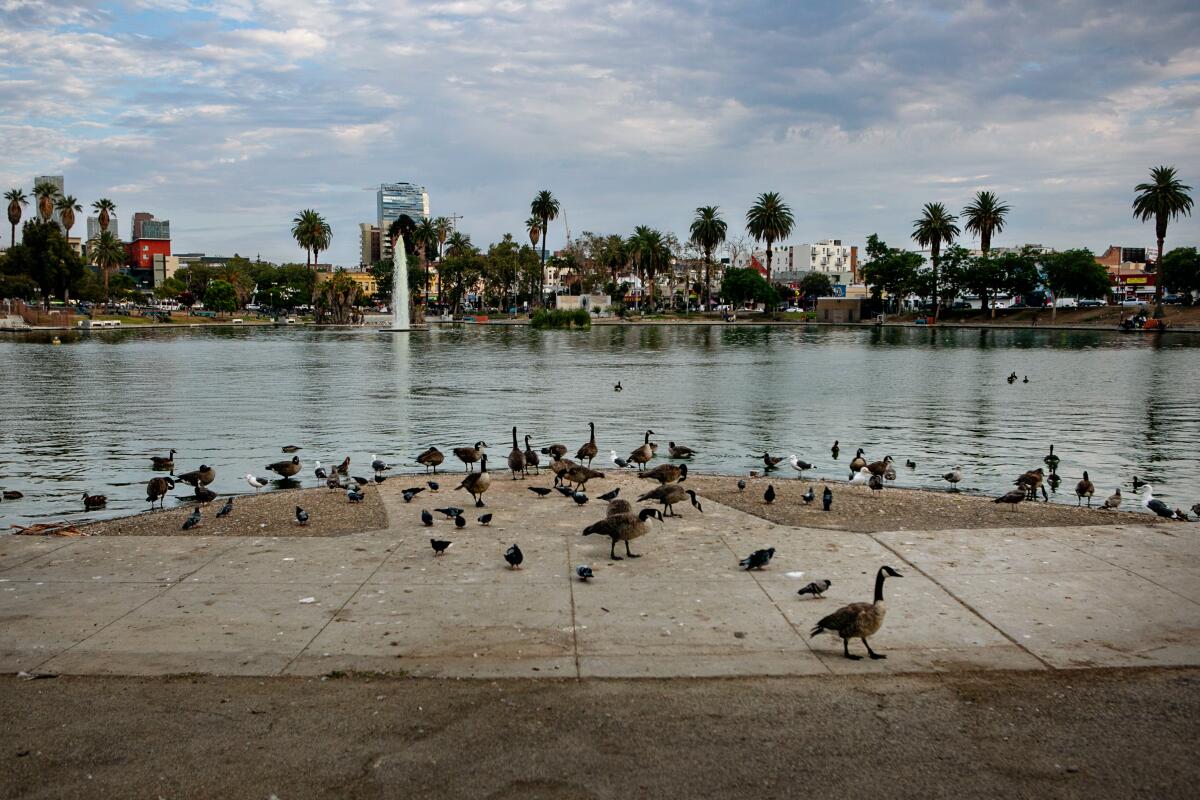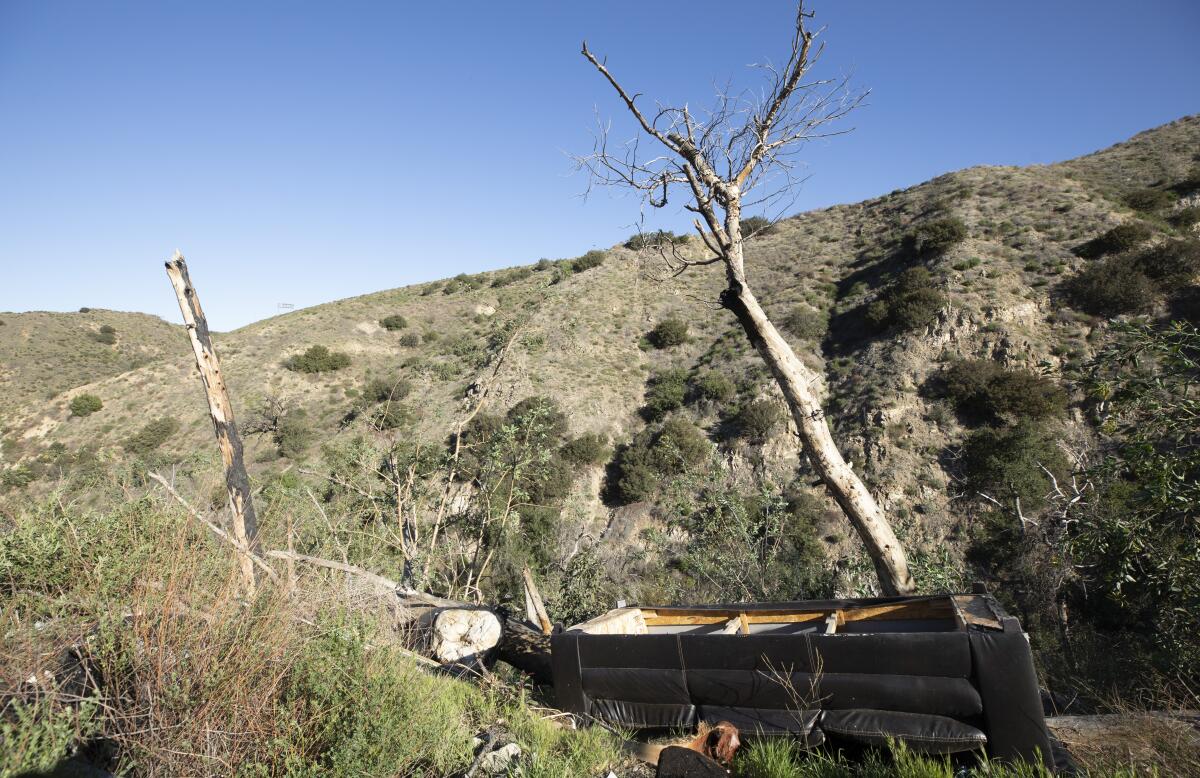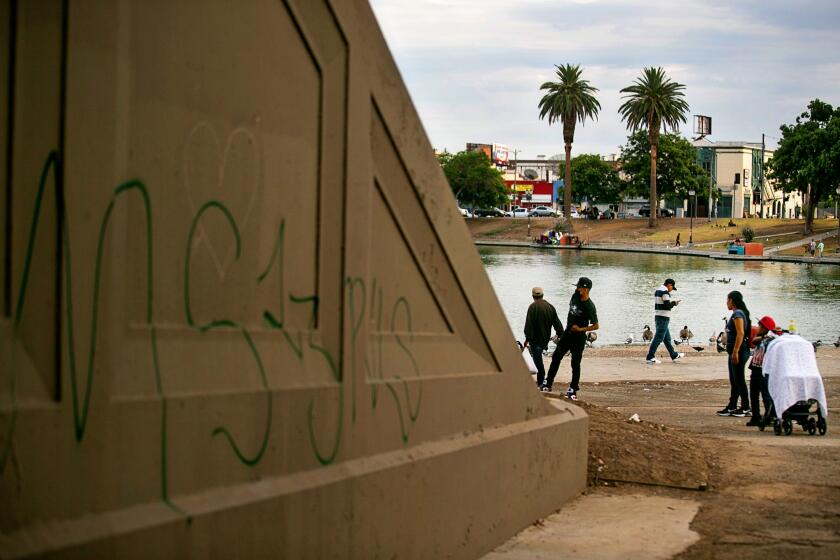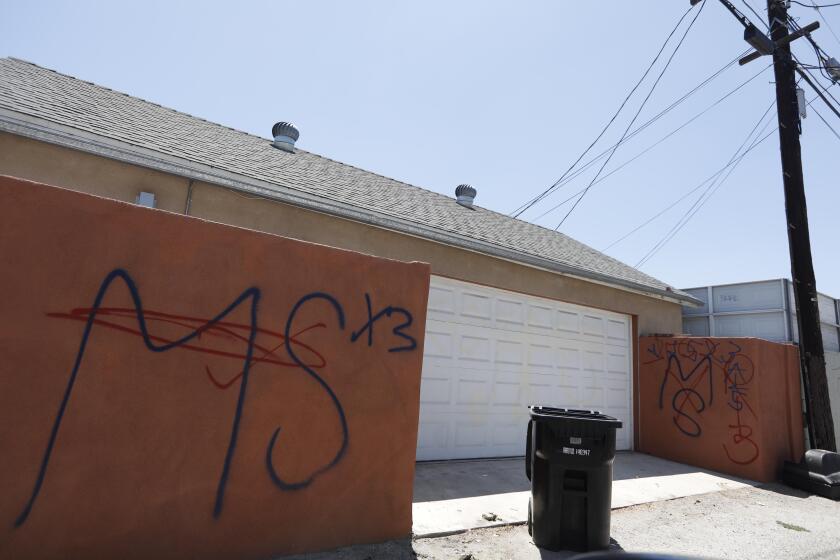He thought it was a date. Instead, he walked into a deadly MS-13 trap

- Share via
Some come to La Tuna Canyon to get rid of what they don’t want.
Strewn across the hillsides just off the Foothill Freeway, among the scrub and a few stubborn trees blackened by wildfire, are broken furniture legs, containers of motor oil, a baby carrier, tires, orange buckets full of broken glass and floor tiles.
Some come here to look for value in what others discard. A little before 8 a.m. on Jan. 19, someone picking through the trash came across the body of a young man.
Bryan Cojon Tuyuc, 20, died, it seems, as he lived — innocently. Believing he was going to meet a woman he’d been messaging online, he drove his uncle’s minivan from the home he shared with his father and into a trap. A construction worker with no criminal record, he was robbed and stabbed to death, then dumped in the canyon, detectives say.
His life stands in stark contrast to that of one of the people accused of taking it. For Gabriel Orellana, his arrest last month on suspicion of killing Cojon Tuyuc was the culmination of a string of violence and misery.
Over the course of a year, Orellana, whom police have identified as a member of the street gang MS-13, has been implicated in the beating of a transgender woman in MacArthur Park, a kidnapping and attempted murder in Griffith Park, and a violent liquor store robbery in Fontana. With no apparent ties to family or anything else beyond the gang, the 19-year-old lived as an indigent on the streets of Los Angeles.
The attacks demonstrate that MS-13 gangs continue to hold the poorest and most marginalized who live and work in the neighborhood in their grip.
The portrait of Orellana gleaned from court records and interviews illustrates the untethered and precarious existence shared by MS-13 members, one defined by crude, subsistence-level crimes and punctuated by flashes of extreme violence.
::
Many members of MS-13 know one another only by their nicknames. In every clique, or subset, of the gang, there will almost surely be a Grumpy and a Dopey, a Flaco (Skinny) and a Pelon (Bald). There are also Killers and Diablos.
Orellana, according to court records, was known as Chaparro and Ordinario. Shorty and Ordinary.
Born in El Salvador, it isn’t clear when or how Orellana, 19, came to the United States, a probation officer wrote in a report. He lived at different times in tents near MacArthur Park and a row of makeshift shacks on Park View Street, said Officer Christabel Youssef, who has investigated MS-13 as part of a gang detail in the Los Angeles Police Department’s Rampart Division.
MS-13 traces its roots to the 1980s, when Salvadorans, dislodged by civil war and poverty, settled in the Westlake, Pico-Union and Rampart districts just west of downtown Los Angeles. In these neighborhoods — some of the poorest and most crowded in the city — Salvadoran teens and young adults with a common interest in heavy metal music and a need to protect themselves against entrenched Mexican American gangs banded together into “stoner” groups, authorities say. In time, the groups coalesced into a single gang, La Mara Salvatrucha, or MS-13.
Subscribers get early access to this story
We’re offering L.A. Times subscribers first access to our best journalism. Thank you for your support.
Orellana has given police different names during various arrests: Gabriel Orellana in some cases, Antonio Orellana or Juan Hernandez in others, according to probation records. Detectives used his fingerprints to confirm his identity. At some point in his brushes with the law, Orellana was labeled with a “special handling code” of being “mentally disturbed,” his probation report says.
His lawyer didn’t respond to requests for comment.
The first time Orellana appears in court records was January of 2021, when LAPD detectives were tracking a phone taken from a man who had been kidnapped in South Los Angeles.
After forcing him into a car at knifepoint, the abductors realized they had taken the wrong person, Det. Christian Mrakich wrote in an affidavit seeking a search warrant. They drove the man, a cook at a Mexican restaurant, to Griffith Park, where they stabbed him in the stomach and beat him with a baseball bat, according to the affidavit. Thinking he was dead, they left the cook on a hillside, taking his phone with them.
Three people were slain within the blighted rooms of the MS-13 destroyer on Rampart Boulevard in 2017 and 2018, authorities said.
Detectives tracked it to a block of Ardmore Avenue in Koreatown, according to the affidavit. At 10 a.m. on Jan. 7, they were staking out a makeshift shelter covered in a blue tarp when Orellana and a teenage boy emerged. Orellana was carrying the cook’s phone, which had photographs of the cook bound and gagged stored on it, Mrakich wrote.
Orellana wasn’t charged with the kidnapping, and police have not put forth any evidence indicating he was involved beyond possessing the phone.
Ten weeks later, two LAPD officers were called to a hospital, where a woman was having stitched shut a cut on her head.
The woman, who is transgender, said she was walking in MacArthur Park when Orellana and another person asked what she was doing in the park, according to a probation report. Orellana demanded that the woman leave, then punched her several times in the face, the report says. She fell to the ground, and he kicked her before fleeing, the woman reported.

Police found Orellana in a tent on the western edge of the park and arrested him. Prosecutors charged him with assaulting the woman, alleging it amounted to a hate crime.
The woman was attacked around the time when members of MS-13 had been extorting money from transgender women in MacArthur Park. Five months earlier, a woman who said she paid the gang $20 a week to be allowed in the park, was stabbed nearly to death by three MS-13 members.
Federal prosecutors expanded a case against the MS-13 gang, securing an indictment that charges nine new defendants and implicates the gang in four murders.
Orellana’s victim, however, told the police she’d been beaten “essentially for no reason,” said Youssef, the Rampart officer who investigated the attack.
Orellana sat in jail for three months. On July 6, he pleaded no contest to a reduced charge of false imprisonment, according to a transcript of the hearing. A judge gave him credit for the 108 days he’d been locked up and released him to a residential drug treatment program. He was ordered to stay 100 feet away from MacArthur Park and his victim, to enroll in a program at Homeboy Industries, and to complete 12 hours of “transgender cultural and sensitivity training” provided by the Los Angeles LGBT Center, the transcript shows.
It was not the punishment a probation officer had recommended. Though Orellana had no prior criminal record and “may have mental health issues that need to be addressed,” his crime was “committed due to hate” and his victim was “particularly vulnerable,” the officer wrote in a report submitted to the court.
“The defendant made the decision to disregard the safety of the victim and should be held accountable for his heinous actions,” the report says. If convicted, Orellana should be sent to prison, the probation officer wrote.

In an interview, Deputy Dist. Atty. Richard Ceballos, who prosecuted the case, said he had little choice but to reduce the charge against Orellana because the victim would not testify.
Ceballos said he had agreed to the proposal by Orellana’s lawyer that he go to the drug treatment program and enroll in the training in part because it offered Orellana a place to sleep. He knew Orellana had been homeless and, absent a court-ordered alternative, would probably return to living in MacArthur Park.
“The one thing I didn’t want was for him to be near the park,” Ceballos said. As for the rehabilitation efforts, “you kind of hope and pray it will work,” he said.
Four months after he was released from jail, Fontana police arrested Orellana on suspicion of robbing a liquor store in the Inland Empire city, said Sgt. Christian Surgent, a spokesman for the Fontana Police Department. A customer was pistol-whipped and a clerk was shot in the face with a BB gun during the Nov. 23 holdup, according to Surgent. Orellana and the other suspects — three juveniles — had been living in a Motel 6 in Fontana when they were arrested, he added.
A spokeswoman for the San Bernardino County district attorney’s office said Orellana has not been charged with a crime.
::
Bryan Cojon Tuyuc told his father he was going out for a bit and would be back soon. He didn’t say where he was going, but he seemed happy, excited about something, his father, Edgar Cojon, recalled in an interview.
Someone had hit his pickup a few weeks earlier, so Bryan borrowed his uncle’s Honda Odyssey and drove off.
About an hour and a half later, Cojon called his son. Bryan had recently landed a job on a construction crew helping build the Metro train line to the airport, and needed to leave for work at 4 a.m. Cojon didn’t want him staying out late.
The call went to voicemail. He called again half an hour later. This time, the phone was off.
“He never does that,” Cojon thought. “He always answers me.”
Cojon had left his native Guatemala for the United States when his son was 7. Bryan remained in Guatemala with his mother and brother before setting out to join his father at 12. Caught trying to cross into the U.S., he was allowed on account of his age to join his father in South L.A., where they lived in a modest three-bedroom home.
Bryan spent his time like many teenagers, playing soccer with friends, skateboarding, tinkering with cars and driving trucks and four-wheelers in the desert, his father said. He spoke nearly every day with his mother and brother back in Guatemala. After graduating from Locke College Preparatory Academy in 2020, he told his dad he wanted to work in construction, like him. He worked at various sites until getting a job on the airport project late last year.
Jan. 17 was a Monday. It wasn’t like Bryan to stay out when he had work the next morning, Cojon thought. He dragged a chair in front of their house. He waited there all night.
The next morning, he drove to the construction site at LAX. “I hoped in my heart that he would be there,” he said.
Cojon went to the LAPD’s Southeast station. The officers there said it was common for kids to stay out and not tell their parents, he recalled. They asked if his son smoked or drank alcohol. Cojon said he didn’t, that it wasn’t like him not to come home or answer his phone. The officers wouldn’t take a missing-persons report, he said, but they did take down the Honda Odyssey’s plate number and description. They suggested that he check at hospitals to see if his son had been in a crash.
Over the next two days, Cojon went to eight hospitals in and around Los Angeles, he said, begging people at the front desk for information. Each time he was told his son wasn’t there, he felt “muerto en vida,” he said. Alive, but dead.
An employee at one hospital told him to submit a photograph of his son, so they could upload it to an internal system and notify him if he checked in. As Cojon was preparing to send the photograph, two detectives and two police officers knocked on his door. His son had been missing for two days.
For about an hour and a half, he said, they questioned him: What was his son wearing when he last saw him? Did they get along? Did his son use drugs? Only when Cojon told them that he planned to keep searching at hospitals, he recalled, did one of the detectives say he didn’t need to look any longer. His son had been found dead in a canyon.
On the last night of his life, Bryan had driven his uncle’s minivan to the intersection of Laurel Canyon Boulevard and Terra Bella Street in Pacoima, Det. Sharon Kim said in an interview. He had been exchanging messages on social media with Kathia Julissa Coreas Lopez, an alleged MS-13 member, Kim said.
Coreas Lopez, 20, is nicknamed “Traviesa,” or Trickster, according to court records. Her attorney declined to comment.
Based on the messages, it appeared that she was “honey-potting” Cojon Tuyuc — luring him into a trap with the promise of sexual favors, Kim said. Once he got to the intersection in Pacoima, Coreas Lopez, Orellana and a 17-year-old tried to rob Bryan of his money, Kim said.
Detectives believe that he fought back and was stabbed in the struggle. His assailants loaded him into the minivan and drove about 10 miles, to an area of La Tuna Canyon near the 210 Freeway that is used as an illegal dumping ground, and left his body on a hillside, Kim said. Detectives believe Bryan was dead by the time they got to the canyon.

Two days later, someone picking through the dumpsite for things to salvage found his body. Police found his uncle’s minivan later that day, about half a mile from where he’d driven to meet Coreas Lopez, Kim said.
Coreas Lopez, Orellana and the teenager were arrested six days later. Kim declined to describe the evidence that led detectives to identify them as suspects.
In booking records, Coreas Lopez and Orellana reported having no job and living at a home in Pacoima around the corner from the intersection where Cojon Tuyuc thought he was going to meet Coreas Lopez.
One of the suspects indicated to detectives that they believed Cojon Tuyuc was a member of 18th Street, MS-13’s bitter rival. Kim, however, said she’d seen no evidence that he was affiliated with a gang and that he had no criminal record.
Coreas Lopez has pleaded not guilty to charges of murder and robbery. Orellana, who is charged with the same crimes under the name Antonio Orellana, has yet to enter a plea.
Cojon sat on a recent evening in front of his home, in the same spot where he had waited through the night for his son. He scrolled through the photographs on his phone. One showed his son standing proudly in front of his pickup. Another was a selfie that Cojon had taken in the desert, father and son smiling into the camera.
“He’s all I had here,” he said quietly. “He was everything to me.”
Times staff writer Brittny Mejia contributed to this report.
More to Read
Sign up for Essential California
The most important California stories and recommendations in your inbox every morning.
You may occasionally receive promotional content from the Los Angeles Times.
















